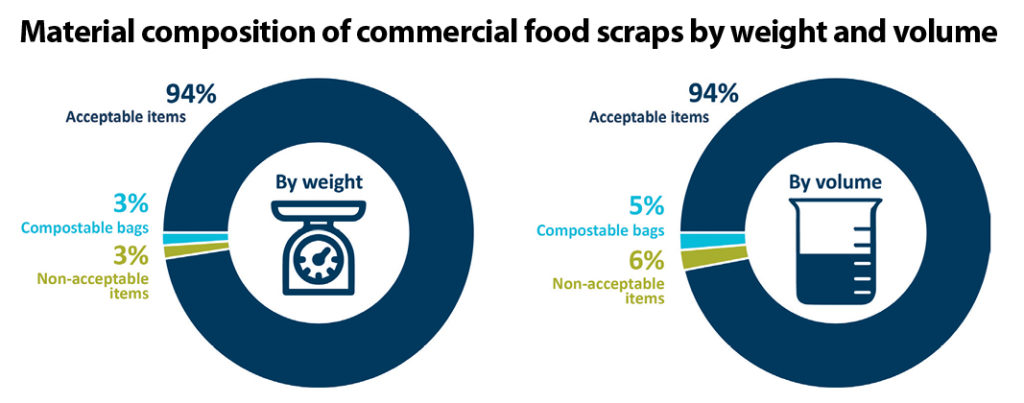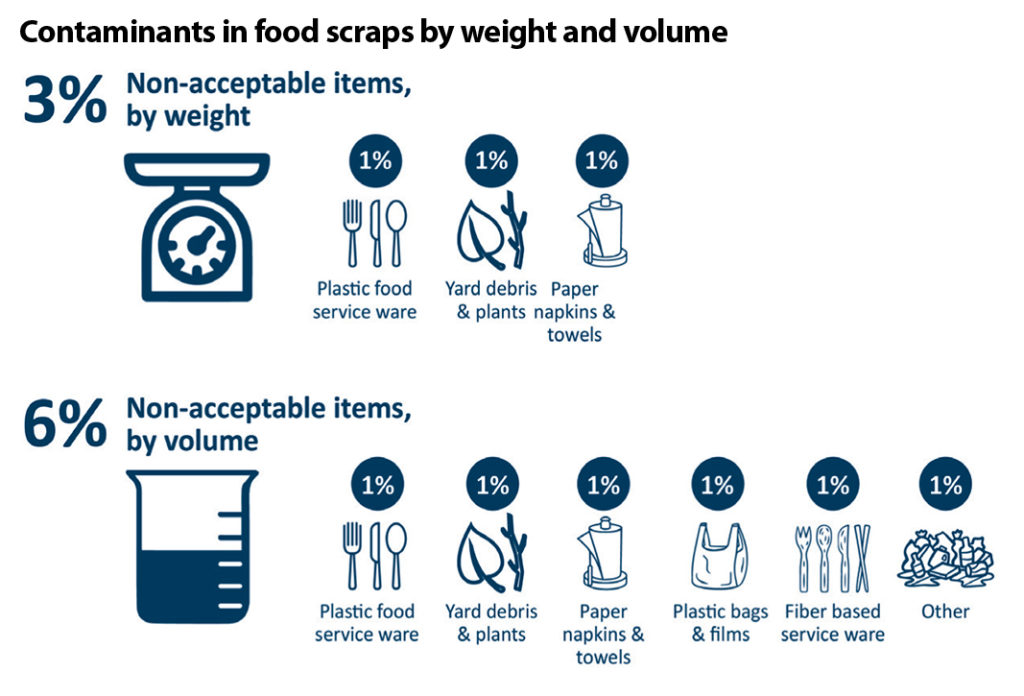In November 2019, Metro, a directly-elected regional government headquartered in Portland, Oregon, completed the “Commercial Food Scraps Composition Study” to evaluate the amount and types of nonacceptable material, known as contaminants, placed in food scraps bins by businesses and their employees in the Metro region. The business food scraps program is food only, although materials can be collected in BPI-certified compostable liner bags. Nearly 28,000 pounds of food scraps, or 50 samples, were collected and sorted. “This study was designed to identify the most prevalent types of contamination in a program with a food-only acceptance standard,” explains a report with the findings released in November 2020. “The results of the study also provide a baseline for contamination rates prior to the implementation of the Business Food Waste Requirement, scheduled for implementation beginning in spring 2021. Findings will be used to update acceptance standards and inspection protocols for incoming loads of commercial food scraps to Metro transfer stations and other facilities receiving Metro-region food scraps for processing.”
In July 2018, the Metro Council adopted a new policy requiring the largest food service businesses to separate their food scraps from other garbage starting in March 2020, with smaller food service businesses phased in over the following three to four years. The policy also requires city and county governments, which oversee collection of garbage and recycling, to ensure that food scraps collection services are available to businesses in their communities starting in March 2020. Due to the unanticipated impacts of the COVID-19 pandemic, the implementation of the collection requirement has been delayed by one year to March 2021. A commercial food waste disposal ban is set to be effective in January 2025.
Most waste characterization studies to measure material streams are based on weight but Metro’s study includes results based on an assessment of both weight and volume. “Measuring both weight and volume provides a more complete picture of source separated food scraps because it normalizes the differences between heavy and light materials,” notes Metro. “The most problematic contaminants in food waste loads are lightweight plastics. Measuring by volume allows for a clearer picture of true contamination. In addition, the volume-based results are also more effective in providing useful information for load-check protocols that are visual in nature.”

 The study showed an average contamination rate for all samples combined of 3% by weight and 6% by volume. Compostable can liners were 3% of the samples by weight and 5% percent of the samples by volume. The 3% contamination by weight represented 1% each of plastic foodservice ware, yard debris and plants, and paper napkins and towels. The 6% by volume also represented 1% each of those same items, plus 1% each of plastic bags and films, fiber-based serviceware and other. “Despite the low contamination rate baseline established through this study, the advent of a mandatory program could bring added contamination due to the increased number of participants,” concludes Metro’s report. “In addition, current participants are in the program voluntarily — they have intentionally chosen to separate food scraps for higher and better use and may be more vigilant about material quality. Continued close monitoring of incoming loads, tight quality standards, and rejecting loads with excessive contamination will remain an important feedback loop for businesses, haulers and local governments. More importantly, the high quality technical assistance and education provided to program participants by local governments is critical in maintaining the low contamination rate the program benefits from today. Without high quality incoming material, the region’s ability to maintain stable and sustainable markets for food scraps is unlikely.”
The study showed an average contamination rate for all samples combined of 3% by weight and 6% by volume. Compostable can liners were 3% of the samples by weight and 5% percent of the samples by volume. The 3% contamination by weight represented 1% each of plastic foodservice ware, yard debris and plants, and paper napkins and towels. The 6% by volume also represented 1% each of those same items, plus 1% each of plastic bags and films, fiber-based serviceware and other. “Despite the low contamination rate baseline established through this study, the advent of a mandatory program could bring added contamination due to the increased number of participants,” concludes Metro’s report. “In addition, current participants are in the program voluntarily — they have intentionally chosen to separate food scraps for higher and better use and may be more vigilant about material quality. Continued close monitoring of incoming loads, tight quality standards, and rejecting loads with excessive contamination will remain an important feedback loop for businesses, haulers and local governments. More importantly, the high quality technical assistance and education provided to program participants by local governments is critical in maintaining the low contamination rate the program benefits from today. Without high quality incoming material, the region’s ability to maintain stable and sustainable markets for food scraps is unlikely.”













